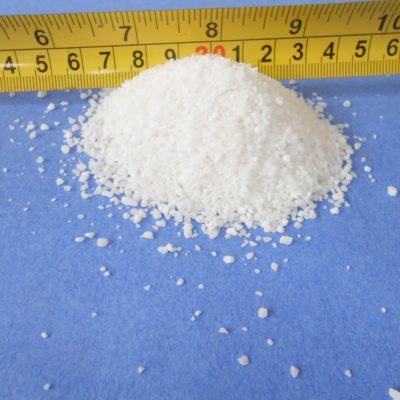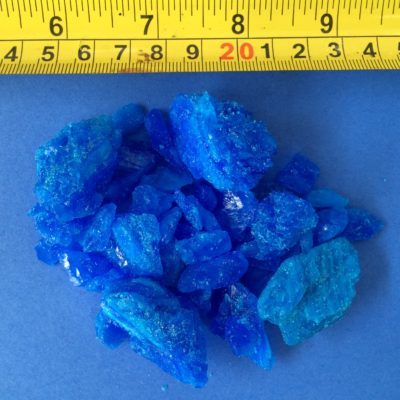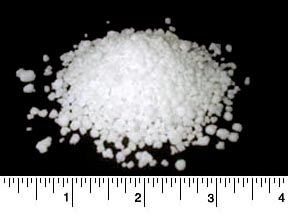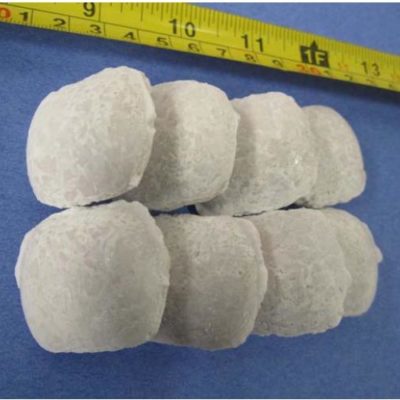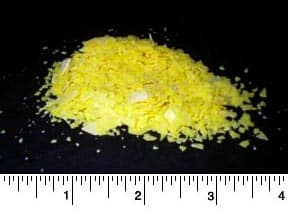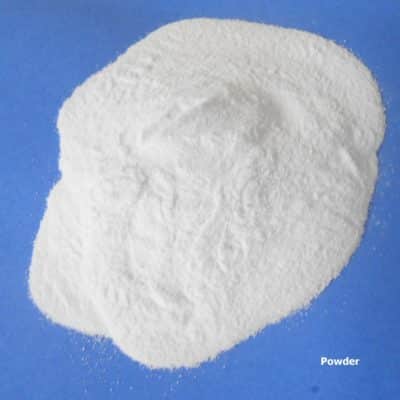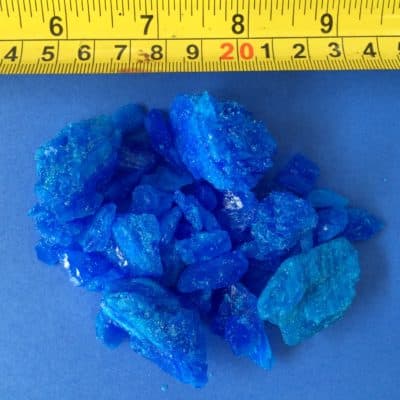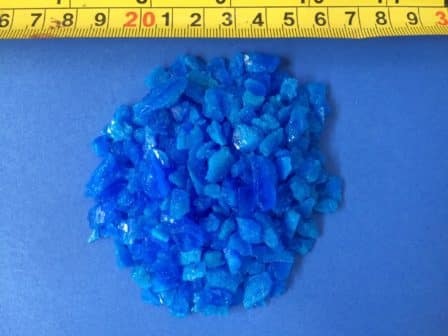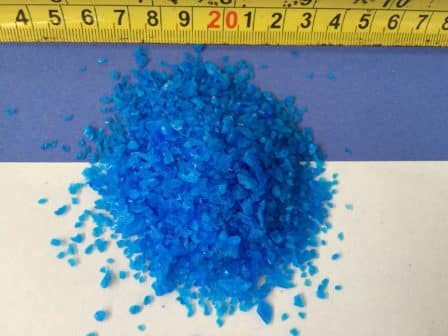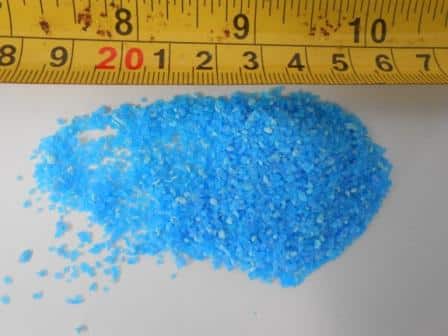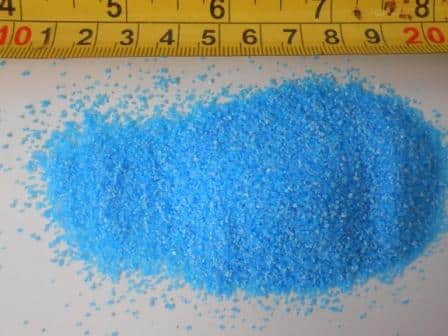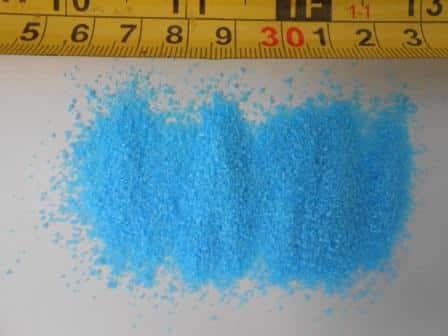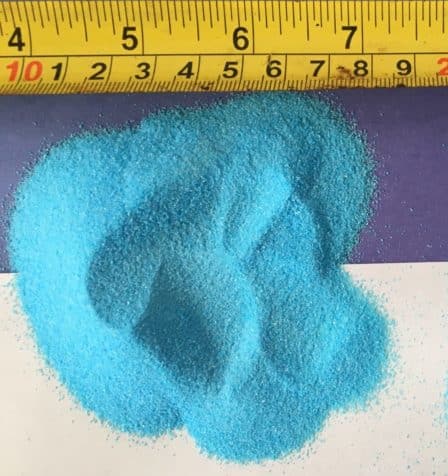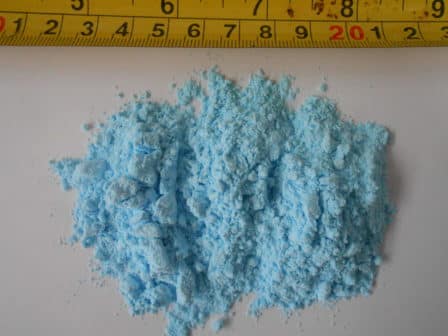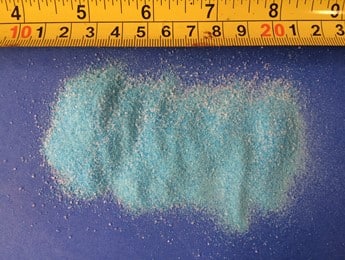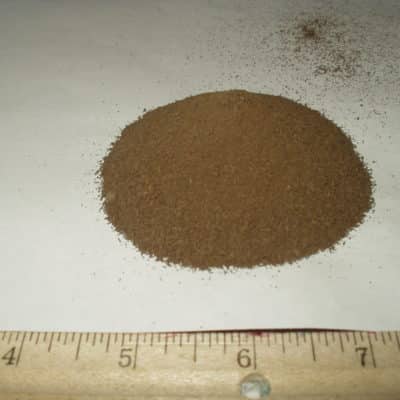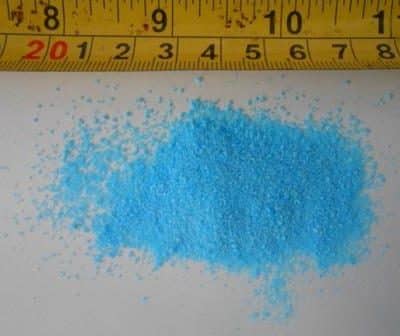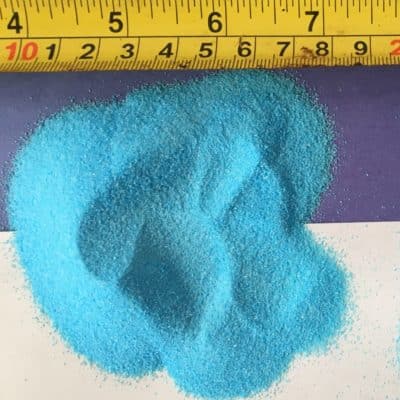Copper Sulfate Pentahydrate
Chem One is the leading supplier of Copper Sulfate for the US market with our extensive lines of Chem One branded products. We are also the exclusive or select distributor for key manufacturers located throughout the world. We store and offer these products at our facilities in Houston, Texas, Laredo, Texas, and Tampa, Florida.
Product Applications for Copper (Cupric) Sulfate Pentahydrate: Agriculture (soil additive, pesticides, Bordeaux mixture), water treating applications, animal feed additive, germicides, textile mordant, leather industry, pigments, electric batteries, electroplated coatings, copper salts, reagent in analytical chemistry, medicine, wood preservative, preservation of pulp wood and ground pulp, process engraving and lithography, ore flotation, petroleum industry, synthetic rubber, steel manufacture, treatment of natural asphalt’s. The anhydrous salt is used as a dehydrating agent.
Product Info
Copper Sulfate Pentahydrate FAQ
In which states does Chem One Ltd. hold pesticide, feed, and fertilizer registrations for Copper Sulfate Crystals?
States where Chem One holds Pesticide Registration:
AL, AK, AR AZ, CA, CO, CT, DE, FL, GA, ID, HI, IL, IN, IA, KS, KY,LA, MA, MD, ME, MI, MN, MO, MS,MT, NE, ND, NH, NJ, NV, NM, NC, NY, OH,OK, OR, PA, RI, SC, SD, TN, TX, UT,VA, VT, WA, WV, WI, WY (all states)*see State Restrictions
States where Chem One holds Fertilizer Registration:
AL, AZ, AR, CA, CO, CT, DE, GA, IL, IN, IA, KS, KY, MA, MI, MN, MS, MO, MT, NE, NV, NM, NY, NC, OH, OK, OR, PA, SC, SD, TN, TX, UT, WA, WI, WY *see State Restrictions
States where Chem One holds Feed Registration:
AR, CA, DE, GA, ID, IL, IA, MI, NE, NM, SC, TX, WI *see State Restrictions
State Restrictions
California
Copper Sulfate – Pesticide Mill Assessment will be charged on all product sold into pesticide applications at a rate of .02175 cents per dollar invoiced.
Copper Sulfate – Fertilizer Mill Assessment will be charged on all product sold into fertilizer applications at a rate of 0.0025 cents per dollar invoiced.
Idaho
Copper Sulfate – Product sold into the state for fertilizer applications must have a fertilizer bag.
Maine
Copper Sulfate – Sales into the State of Maine can only be sold to licensed applicators – Stop and check that your customer is aware that they can only sell to a licensed applicator.
New Jersey
Copper Sulfate – Sales into the State of New Jersey can only be sold to licensed applicators – Stop and check that your customer is aware that they can only sell to a licensed applicator. We (Chem One) are required to notify our customer of this restriction in New Jersey.
New York
Copper Sulfate – Chem One cannot sell directly into New York without an Applicator’s Permit. The Chem One Permit has been cancelled. Therefore, Chem One can only sell through a permit-holder for restricted pesticides. The State of New York also requires Chem One to ask each customer if they have a permit to sell State- restricted pesticides in New York.
Washington
Copper Sulfate – Sales into the State of Washington can only be sold to licensed applicators – Stop and check that your customer is aware that they can only sell to a licensed applicator.
Wisconsin
Copper Sulfate – Chem One is charged fees based upon dollar volume of pesticide shipped and used into this state. We normally do not reach high fee amounts; however it is tracked and you will be notified if your sale exceeds volume dollars.
Is there a waiting period before I can use the water for drinking, cattle watering, irrigation, eating fish in a copper sulfate- treated pond or lake?
If the treated water is to be used as potable (drinking) water, the concentration of copper sulfate must not exceed 4 ppm. This concentration is also expressed as 1 ppm Cu.
It is recommended that swimming is not allowed for 24 hours.
Sheep are extremely sensitive to copper; do not allow sheep to drink treated water. Refer to label or call Chem One Representative if more questions.
How long must I wait to go swimming after treatment with copper sulfate for swimmer’s itch and/or algae control?
Not allowing swimming for 24 hours is recommended. Freshly treated areas should be avoided because of the corrosive nature of copper sulfate to skin, eyes, and digestive tract.
Where do organic growers find out whether the use of copper sulfate is acceptable in their application?
Organic growers must clear all products with their certifier. Manufactures may have the OMRI sticker on their bag or container, but the grower must clear the use and application rate of the product with their certifier. Chem One copper sulfate is OMRI Listed for disease control (which would include making Bordeaux mixtures), for algaecide in rice fields, and for control of tadpole shrimp in rice fields. Chem One copper sulfate has also been listed by OMRI as a fertilizer component.
Is Copper Sulfate OMRI Listed for organic crop production?
We are OMRI Listed for Copper Sulfate Crystals for CROP PEST, WEED and DISEASE CONTROL.
For plant disease control, must be used in a manner that minimizes accumulation of copper in the soil. For use as an algicide in aquatic rice systems and for tadpole shrimp control in aquatic rice systems, must not exceed one application per field during any 24-month period. Application rates are limited to those which do not increase baseline soil test values for copper over a time frame agreed upon by the producer and accredited certifying agent. May be used as an algicide, insecticide, or disease control if the requirements of 205.206(e) are met, which requires the use of preventative, mechanical, physical, and other pest, weed, and disease management practices.
We are OMRI Listed for Copper Sulfate Crystals FOR CROP FERTILIZERS and SOIL AMENDMENTS
May be used as a plant or soil amendment if soil deficiency of copper is documented by testing. Must not be used as a defoliant, herbicide, or desiccant.
However California has its own program (California Organic Materials Input or OIM) therefore we have to register separately with them and we are only certified with them for Fine 20, Fine 25 and Small they were only accepted by the California OIM because they do not contain an Anti-Caking Agent.
What is the solubility of copper sulfate
SOLUBILITY OF COPPER SULFATE*
Temperature Pounds of Copper Sulfate Crystals (CuSO4.5H2O)
Celsius Fahrenheit per 100 lbs. solution per 100 gallons water
0 32 19.5 186.0
10 50 23.1 226.8
20 68 26.9 269.4
25 77 28.9 296.1
30 86 31.3 326.1
40 104 35.2 371.1
50 122 39.1 433.7
60 140 44.5 521.3
80 176 55.5 717.2
*Frank E. Hale’s Copper Sulfate in Water Treatment
In which states is copper sulfate a State Restricted pesticide and what are the requirements?
A: Copper sulfate is a State Restricted Pesticide in New York, Maine, and New Jersey.
New York: Chem One can not sell directly into New York without an Applicator’s Permit. The Chem One Permit has been cancelled. Therefore, Chem One can only sell through a permit-holder for restricted pesticides. The State of New York also requires Chem One to ask each customer if they have a permit to sell State-Restricted pesticides in New York.
Maine has listed Copper Sulfate as an “aquatic herbicide”. Chem One can not sell direct to an end user in the State of Maine.. Chem one would need to become a restricted use Pesticide Dealer.
New Jersey states that “anyone distributing a state-restricted use pesticide to a retail dealer or whole distributor for resale, is to inform the purchaser that it is a restricted use pesticide in New Jersey.”
Washington has listed copper sulfate as RUP, meaning that it can only be sold through licensed dealers who sell to licensed applicators within the state.
All States require that Chem One be registered before a pesticide can be sold into that particular state.
What is the oily film that forms when I make a pail full of copper sulfate pentahydrate solution in tap water?
When copper sulfate pentahydrate is dissolved in hard water, i.e. containing calcium carbonate, an “oily white film” will quickly form on the surface. This is copper carbonate, which is insoluble in water. This reaction will occur at pH values of 6 or higher. If the pH is subsequently dropped below pH 4 with acid (e.g. sulfuric, hydrochloric, or citric acid) , the white film will quickly dissolve. Copper sulfate grades with an anti-caking agent will have a more noticeable film.
Where can I find general information on the control of algae and aquatic weeds and general information on use of copper sulfate for algae control?
Please refer to Chem One Copper Sulfate Label
Which sizes of copper sulfate contain anticaking agent?
Copper Sulfate powder (Fine 200, Fine 100, Fine 30) contain an anti-caking agent (e.g. Magnesium carbonate, calcium carbonate); larger sizes (Fine 20 – Large) do not. Anti-caking agent creates a film on fine 30 crystals.
I never used copper sulfate before, where should I begin? How harmful is it?
Read the label and follow the instructions! Request a Safety Data Sheet and read it before using this product. Copper sulfate is corrosive to humans, animals as well as to metals. The label must be read to gain an understanding of how to correctly apply copper sulfate to treat surface or bottom-dwelling algae, how to avoid fish kills, please refer to label or contact your Chem One Representative.
Why is my solution of Copper Sulfate Fine 100 “cloudy”?
A Fine 100 copper sulfate solution will sometimes be cloudy, because it is very dry and has a lower pH than the other crystal sizes and it has an anti-caking agent added. With a few drops of acid (e.g., citric acid), the solution becomes clear.
How much copper sulfate is needed to treat a 13 million gallon tank?
The easiest way to determine the amount to use is to convert gallons to acre ft: 1 acre ft = 326,000 gal; 13 million gal is 39.877 acre ft. multiply acre ft by 5.44 lbs CuSO4 to get the recommended concentration (i.e. 2 ppm CuSO4).
How can I remove copper sulfate stains?
Copper sulfate stains can be removed with muriatic acid (dilute HCl). Be sure muriatic acid is safe to use on the surface you are cleaning. Note that muriatic acid is corrosive to many surfaces and to skin.
How do I spray copper sulfate on a pond surface?
First, determine how many acre feet you are treating. For example, if treating 1 acre foot, dissolve 5.44 lbs in your spray tank ( because 5 .44 lbs will dissolve in 2 to 3 gallons of water; then this amount of copper sulfate will readily dissolve in larger spray tanks.). If the pond or lake contains fish, treat only one-half to one third at one time. In this example, use one-half (2.72 lbs) or one- third (1.81 lbs) the amount of copper sulfate of each treatment. Wait 2 weeks before treating the next section.
How much copper sulfate should be used for algae control?
The Copper Sulfate Crystals label gives instructions under the heading “CALCULATIONS OF ACTIVE INGREDIENT TO BE ADDED” for calculating the amount of Copper Sulfate Pentahydrate to treat 1 acre-foot of water with 2 ppm Copper Sulfate Pentahydrate. The amount listed is 5.44 lbs. Thus, for a 2 ppm concentration, to treat a 1 acre pond with an average depth of 4 feet, 5.44 lbs x 4 (21.76 lbs) would be used. Referring to the list of algae on the label, lower amounts (1/4 up to 2 ppm) can be used to treat for most species.
In which states is Copper Sulfate restricted for use as a root killer in sewer and/or septic systems?
Copper Sulfate is restricted for use for root control in the following states:
1. State law prohibits the use of this product in all sewage systems in the State of Connecticut.
2. Not for sale or use in the California counties of Alameda, Contra Costa, Marin, Napa, San Francisco, San Mateo, Santa Clara, Solano, and Sonoma for root control in sewers.
3. Not for sale or use in septic systems in the States of Florida, Massachusetts and Washington. However, it can be used in sewer systems in these states.
What is Tribasic Copper Sulfate?
Tribasic copper sulfate, also called “basic” copper sulfate, has the following formula: CuSO4*3Cu (OH) 2, CAS no. 12068-81-4. “Tribasic” indicates that this compound has three Cu (OH) 2’s in the formula. Main use is as a foliar fungicide.
How is copper sulfate manufactured?
The production of copper sulfate uses the Harike (1950) method. Copper wire (feed stock can be copper telephone wire with the plastic stripped away or motor turnings), is reacted with technical grade sulfuric acid solution and air to produce copper sulfate and water. This reaction is done in a tower or vat, where heated sulfuric acid solutions and air can be circulated through the copper wire. Copper sulfate crystals precipitate from the acid solution and are collected. The crystals are washed with water to remove remaining sulfuric acid, air-dried, crushed, and sieved to produce copper sulfate product of various granularities. Acid solutions are recycled/reused.
Is NSF certified Copper Sulfate needed for treating ponds, irrigation ditches, etc for algae-control?
No. NSF is usually designated for municipalities in treating potable drinking water. There is a list of states he NSF publishes that have, do not have, or are changing their requirements for NSF certified material.
Why do Copper Sulfate Fine 20 crystals have a white residue?
The white coating is copper monohydrate created during drying of the copper sulfate pentahydrate. It will dissolve and not leave a residue.
How much copper sulfate is needed to treat a 13 million gallon tank?
The easiest way to determine the amount to use is to convert gallons to acre ft: 1 acre ft = 326,000 gal; 13 million gal is 39.877 acre ft. multiply acre ft by 5.44 lbs CuSO4 to get the recommended concentration (i.e. 2 ppm CuSO4).
How much copper sulfate should be used for algae control?
The Copper Sulfate Crystals label gives instructions under the heading “CALCULATIONS OF ACTIVE INGREDIENT TO BE ADDED” for calculating the amount of Copper Sulfate Pentahydrate to treat 1 acre-foot of water with 2 ppm Copper Sulfate Pentahydrate. The amount listed is 5.44 lbs. Thus, for a 2 ppm concentration, to treat a 1 acre pond with an average depth of 4 feet, 5.44 lbs x 4 (21.76 lbs) would be used. Referring to the list of algae on the label, lower amounts (1/4 up to 2 ppm) can be used to treat for most species.
What sizes of copper sulfate do you carry?
Guide to Copper Sulfate Crystals Sizes
Copper Sulfate Pentahydrate is sold in various crystal sizes. Since there is no uniform standard on describing the crystal sizes, the information that follows may assist you in making comparisons. Please do request a sight sample to make certain the crystals size you are buying meets your customer’s specification. This information serves only as a guide.
Chem One Copper Sulfate Crystal Sizes:
Fine 200: 200 mesh material that looks like powdered sugar. Some users call it instant powder or powdered.
Possible applications: Solutions, Algae control (surface spray solution), Cattle Foot Bath
(Hoof Rot), Bordeaux
Fine100: 100 mesh material that has a very fine particle size but not as dusty as the fine 200. It may be referred to as K100, ultra fine
Possible applications: Solutions, Algae control (surface spray solution), Liquid Fertilizer, cattle Foot Bath (Hoof Rot)
Fine 30: A very fine crystal with particles less than a 30 mesh. Used in the feed industry it is may be referred to as super fine, Fine Diamond, K40 or Feed grade.
Possible applications: Feed, Algae Control (a blower may be used to spray dry crystals to treat surface algae and subsurface (10-15 feet), Cattle Foot Bath (Hoof Rot)
Fine 20: A fine crystal with particles less than averaging a 20 mesh. It may be referred to as Rice, Snow, Diamond, Industrial and K30.
Possible applications: Algae control. A blower may be used to spray dry crystals to treat surface algae and subsurface (10-15 feet), Tadpole shrimp and algae in Rice fields, Root control in Sewers, Fertilizer, Swimmers Itch
Fine 25: A fine crystal with particles less than averaging a 20 mesh. It may be referred to as Rice, Snow, Diamond, Industrial and K30.
Possible applications: Algae control. A blower may be used to spray dry crystals to treat surface algae and subsurface (10-15 feet), Tadpole shrimp and algae in Rice fields, Root control in Sewers, Fertilizer, Swimmers Itch
Rice Grade: A fine crystal with particles less than averaging a 20 mesh.
Application: To control Tadpole shrimp and algae in Rice fields
Small: crystal is about 1/8 of an inch (1-4mm). The mesh size is a –4, +18. It may be referred to as granular, Macro, Coarse, or fertilizer size. Some Companies ship a very fine crystal and call this size Small. Investigate the actual size when someone asks for Small to make certain you understand what size they need.
Possible applications: Algae Control-bottom-dwelling algae(boat-dragged burlap bag method for large lakes and reservoirs, Hand broad cast to treat surface and subsurface algae for lake perimeters and small lake, Irrigation ditches , Swimmer’s Itch, Root control, Fertilizer
Medium: This crystal is about ¼ inch (5-8 mm: mesh-5/16, +4) May be referred to as “quarter inch” or “granulated”. Few use this size for fertilizer blending. Most end uses are in water treating or in industrial applications
Possible applications: Algae control–bottom-dwelling algae (boat-dragged burlap bag method for large lakes and reservoirs),Hand broad cast to treat surface and subsurface algae(for lake perimeters and small lakes), Swimmers Itch, Root Control
Large: This crystal is ½ inch to 1 inch. (8-20mm; -3/4 +5/16)) May be referred to as “big crystals” This size crystal is used almost exclusively in water treatment applications.
Possible applications: Algae control-bottom dwelling algae (boat-dragged burlap bag method for large lakes and reservoirs), Hand broad cast to treat surface and subsurface algae for lake perimeters and small lakes, Irrigation ditchers, Swimmers Itch
Chem One uses the names Fine 200, Fine 100, Fine 30, Fine 20, Small, Medium, and Large. We can offer the above crystal sizes as ANSI/NSF 60 Certified.
